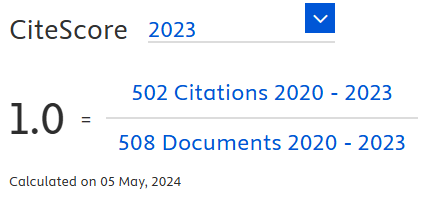Valorization and optimization of Pistachio Shell Biochar for Sustainable Reduction of Hexavalent Chromium [Cr(Ⅵ)]
DOI:
https://doi.org/10.18006/2025.13(2).229.238Keywords:
Pistachio shell, Biochar valorization, Hexavalent chromium, Sustainable biosorptionAbstract
In the leather tanning industry, wastewater often contains hazardous hexavalent chromium [Cr(Ⅵ)]. Adsorption is recognized as an effective method for treating this type of wastewater. However, commercial adsorbents can be costly. This study explores the conversion of pistachio shells into biochar as a cost-effective and reusable adsorbent for chromium removal. The results showed that pistachio shell biochar (PSB) effectively removed up to 400 mg L⁻¹ of Cr(Ⅵ) at a pH of 4, with a contact time of 50 hours and a biochar concentration of 1.2 g L⁻¹. Batch studies indicated that adsorption efficiency depends on pH, biochar dosage, chromium concentration, and contact time. FT-IR analysis identified key adsorption sites for chromium, while SEM images displayed multiple attachment locations. These findings confirm the potential of PSB as an efficient, sustainable, cost-effective, and environmentally friendly approach for chromium remediation.
References
Abid, M., Niazi, N. K., Bibi, I., Farooqi, A., et al. (2016). Arsenic (V) biosorption by charred orange peel in aqueous environments. International journal of phytoremediation, 18(5), 442-449. https://doi.org/10.1080/15226514.2015.1109604 DOI: https://doi.org/10.1080/15226514.2015.1109604
Acharya, C., Mohapatra, R. K., Sasmal, A., Panda, C. R., & Thatoi, H. (2024). Effective remediation of Cr (VI) using coconut coir-derived porous biochar: application of kinetics and isotherm approaches. International Journal of Environmental Science and Technology, 21(10), 7249-7268. https://doi.org/10.1007/s13762-024-05460-8. DOI: https://doi.org/10.1007/s13762-024-05460-8
Ahmed, M. J., & Hameed, B. H. (2018). Removal of emerging pharmaceutical contaminants by adsorption in a fixed-bed column: a review. Ecotoxicology and Environmental Safety, 149, 257-266. https://doi.org/10.1016/j.ecoenv.2017.12.012. DOI: https://doi.org/10.1016/j.ecoenv.2017.12.012
Ali, A., Alharthi, S., Al-Shaalan, N. H., Naz, A., & Fan, H. J. S. (2023). Efficient removal of hexavalent chromium (Cr (VI)) from wastewater using amide-modified biochar. Molecules, 28(13), 5146. https://doi.org/10.3390/molecules28135146. DOI: https://doi.org/10.3390/molecules28135146
Ali, I. H., Al Mesfer, M. K., Khan, M. I., Danish, M., & Alghamdi, M. M. (2019). Exploring adsorption process of lead (II) and chromium (VI) ions from aqueous solutions on acid activated carbon prepared from Juniperus procera leaves. Processes, 7(4), 217. https://doi.org/10.3390/pr7040217. DOI: https://doi.org/10.3390/pr7040217
Babangida, S. K., Muhammad, A., Garba, A., & Sallau, A. B. (2021). Antioxidants in bioremediation of chromium (VI) by conventional and nanotechnological approaches: a review. Toxicological & Environmental Chemistry, 103(2), 162-183. https://doi.org/10.1080/02772248.2021.1947278 DOI: https://doi.org/10.1080/02772248.2021.1947278
Banerjee, S., Misra, A., Chaudhury, S., & Dam, B. (2019). A Bacillus strain TCL isolated from Jharia coalmine with remarkable stress responses, chromium reduction capability and bioremediation potential. Journal of hazardous materials, 367, 215-223. https://doi.org/10.1016/j.jhazmat.2018.12.038 DOI: https://doi.org/10.1016/j.jhazmat.2018.12.038
Biswal, B. K., & Balasubramanian, R. (2023). Use of biochar as a low-cost adsorbent for removal of heavy metals from water and wastewater: A review. Journal of Environmental Chemical Engineering, 110986. https://doi.org/10.1016/j.jece.2023.110986 DOI: https://doi.org/10.1016/j.jece.2023.110986
Cai, W., Wei, J., Li, Z., Liu, Y., Zhou, J., & Han, B. (2019). Preparation of amino-functionalized magnetic biochar with excellent adsorption performance for Cr (VI) by a mild one-step hydrothermal method from peanut hull. Colloids and Surfaces A: Physicochemical and Engineering Aspects, 563, 102-111. https://doi.org/10.1016/j.colsurfa.2018.11.062. DOI: https://doi.org/10.1016/j.colsurfa.2018.11.062
Che, H., Wei, G., Fan, Z., Zhu, Y., et al. (2023). Super facile one-step synthesis of sugarcane bagasse-derived N-doped porous biochar for adsorption of ciprofloxacin. Journal of Environmental Management, 335, 117566. https:// doi.org/ 10.1016/j.jenvman.2023.117566. DOI: https://doi.org/10.1016/j.jenvman.2023.117566
Chen, X., Xia, H., Lv, J., Liu, Y., et al. (2023a). Magnetic hydrothermal biochar for efficient enrichment of uranium (VI) by embedding Fe3O4 nanoparticles on bamboo materials from “one-can” strategy. Colloids and Surfaces A: Physicochemical and Engineering Aspects, 658, 130748. https://doi.org/10.1016/j.colsurfa.2022.130748. DOI: https://doi.org/10.1016/j.colsurfa.2022.130748
Chen, Z., Liu, T., Dong, J., Chen, G., et al. (2023b). Enhanced Cr (VI) reduction and removal by Fe/Mn oxide biochar composites under acidic simulated wastewater. Environmental Science and Pollution Research, 30(11), 31489-31500. https://doi.org/10.1007/s11356-022-24367-w. DOI: https://doi.org/10.1007/s11356-022-24367-w
Chung, N. T., Thuy, D. T., Trang, L. H., & Vu, N. T. (2025). Evaluating coffee husk biochar as a sustainable and novel adsorbent for lead and copper in wastewater. Biomass Conversion and Biorefinery, 1-17. https://doi.org/10.1007/s13399-025-06674-7. DOI: https://doi.org/10.1007/s13399-025-06674-7
Curcio, G. M., Rivera, E. G. A., Limonti, C., Andreoli, T., Sethi, R., & Siciliano, A. (2023). Removal of hexavalent chromium using zero-valent magnesium in a continuous flow system. Journal of Water Process Engineering, 56, 104494. https://doi.org/10.1016/j.jwpe.2023.104494 DOI: https://doi.org/10.1016/j.jwpe.2023.104494
Dahiya, A., Bhardwaj, A., Rani, A., Arora, M., & Babu, J. N. (2023). Reduced and oxidized rice straw biochar for hexavalent chromium adsorption: Revisiting the mechanism of adsorption. Heliyon, 9(11). https://doi.org/10.1016/j.heliyon.2023.e21735. DOI: https://doi.org/10.1016/j.heliyon.2023.e21735
Enaime, G., Wichern, M., & Lübken, M. (2023). Contribution of biochar application to the promotion of circular economy in agriculture. Frontiers in Agronomy, 5, 1214012. https://doi.org/10.3389/fagro.2023.1214012. DOI: https://doi.org/10.3389/fagro.2023.1214012
Fouda-Mbanga, B. G., Velempini, T., Pillay, K., & Tywabi-Ngeva, Z. (2023). Hydrothermal development of magnetic-hydrochar nanocomposite from pineapple leaves and its performance as an adsorbent for the uptake of Mn2+ and reuse of the metal loaded adsorbent in latent fingerprint. Journal of Saudi Chemical Society, 27(3), 101624. https://doi.org/10.1016/j.jscs.2023.101624. DOI: https://doi.org/10.1016/j.jscs.2023.101624
Gupta, G. K., & Mondal, M. K. (2023). Mechanism of Cr (VI) uptake onto sagwan sawdust derived biochar and statistical optimization via response surface methodology. Biomass Conversion and Biorefinery, 13(2), 709-725. https://doi.org/10.1007/s13399-020-01082-5. DOI: https://doi.org/10.1007/s13399-020-01082-5
Hassan, M., Naidu, R., Du, J., Liu, Y., & Qi, F. (2020). Critical review of magnetic biosorbents: Their preparation, application, and regeneration for wastewater treatment. Science of the Total Environment, 702, 134893. https://doi.org/10.1016/ j.scitotenv.2019.134893. DOI: https://doi.org/10.1016/j.scitotenv.2019.134893
Idowu, A. A., Temilade, F. A., Peter, A., Vahidhabanu, S., & Babu, B. R. (2019). Agro waste material as ecofriendly adsorbent for the removal of Zn (II): isotherm, kinetic, thermodynamic and optimization studies. Desalination and Water Treatment, 155, 250-258. https://doi.org/10.5004/dwt.2019.23977 DOI: https://doi.org/10.5004/dwt.2019.23977
Irshad, M. A., Sattar, S., Nawaz, R., Al-Hussain, S. A., et al. (2023). Enhancing chromium removal and recovery from industrial wastewater using sustainable and efficient nanomaterials: a review. Ecotoxicology and Environmental Safety, 263(115231), 10-1016. https://doi.org/10.1016/j.ecoenv.2023.115231 DOI: https://doi.org/10.1016/j.ecoenv.2023.115231
Isaac, R., & Siddiqui, S. (2022). Sequestration of Ni (II) and Cu (II) using FeSO4 modified Zea mays husk magnetic biochar: Isotherm, kinetics, thermodynamic studies and RSM. Journal of Hazardous Materials Advances, 8, 100162. https://doi.org/10.1016/j.hazadv.2022.100162. DOI: https://doi.org/10.1016/j.hazadv.2022.100162
Juturu, R., Selvaraj, R., & Murty, V. R. (2024). Efficient removal of hexavalent chromium from wastewater using a novel magnetic biochar composite adsorbent. Journal of Water Process Engineering, 66, 105908. https://doi.org/10.1016/j.jwpe.2024.105908. DOI: https://doi.org/10.1016/j.jwpe.2024.105908
Khalil, U., Shakoor, M. B., Ali, S., Ahmad, S. R., et al. (2021). Selective removal of hexavalent chromium from wastewater by rice husk: kinetic, isotherm and spectroscopic investigation. Water, 13(3), 263. https://doi.org/10.3390/w13030263. DOI: https://doi.org/10.3390/w13030263
Khazaei, I., Aliabadi, M., & Hamed, M. H. (2011). Use of agricultural waste for removal of Cr (VI) from aqueous solution Iranian Journal of Chemical Engineering, 8(4). https://www.sid.ir/EN/VEWSSID/J_pdf/102420110402.pd
Kokab, T., Ashraf, H. S., Shakoor, M. B., Jilani, A., et al. (2021). Effective removal of Cr (Vi) from wastewater using biochar derived from walnut shell. International Journal of Environmental Research and Public Health, 18(18), 9670. https://doi.org/10.3390/ijerph18189670. DOI: https://doi.org/10.3390/ijerph18189670
Li, D., Wang, M. Q., & Lee, C. (2020). The waste treatment and recycling efficiency of industrial waste processing based on two-stage data envelopment analysis with undesirable inputs. Journal of Cleaner Production, 242, 118279. https://doi.org/10.1016/j.jclepro.2019.118279. DOI: https://doi.org/10.1016/j.jclepro.2019.118279
Manikandan, S. K., Pallavi, P., Shetty, K., Bhattacharjee, D., et al. (2023). Effective usage of biochar and microorganisms for the removal of heavy metal ions and pesticides. Molecules, 28(2), 719. https://doi.org/10.3390/molecules28020719. DOI: https://doi.org/10.3390/molecules28020719
Maremeni, L. C., Modise, S. J., Mtunzi, F. M., Klink, M. J., &Pakade, V. E. (2018). Adsorptive Removal of Hexavalent Chromium by Diphenylcarbazide‐Grafted Macadamia Nutshell Powder. Bioinorganic Chemistry and Applications, 2018(1), 6171906. https://doi.org/10.1155/2018/6171906. DOI: https://doi.org/10.1155/2018/6171906
Mkilima, T., Zharkenov, Y., Abduova, A., Sarypbekova, N., et al. (2024). Investigating the potential of wheat straw and pistachio shell as a bio-functionalized agricultural waste biomass for enhanced biosorption of pollutants from wastewater. Case Studies in Chemical and Environmental Engineering, 9 (2024), 100662. https://doi.org/10.1016/j.cscee.2024.100662. DOI: https://doi.org/10.1016/j.cscee.2024.100662
Mohan, D., Rajput, S., Singh, V. K., Steele, P. H., & Pittman Jr, C. U. (2011). Modeling and evaluation of chromium remediation from water using low-cost bio-char, a green adsorbent. Journal of hazardous materials, 188(1-3), 319-333. https://doi.org/10.1016/ j.jhazmat.2011.01.127. DOI: https://doi.org/10.1016/j.jhazmat.2011.01.127
Nguyen, D. K., Ly-Tran, Q. B., Dinh, V. P., Duong, B. N., Nguyen, T. P. T., & Tuyen, P. N. K. (2024). Adsorption mechanism of aqueous Cr (vi) by Vietnamese corncob biochar: a spectroscopic study. RSC advances, 14(53), 39205-39218. https://doi.org/10.1039/D4RA07455F. DOI: https://doi.org/10.1039/D4RA07455F
Peng, H., & Guo, J. (2020). Removal of chromium from wastewater by membrane filtration, chemical precipitation, ion exchange, adsorption electrocoagulation, electrochemical reduction, electrodialysis, electrodeionization, photocatalysis and nanotechnology: a review. Environmental chemistry letters, 18(6), 2055-2068. https://doi.org/10.1007/s10311-020-01058-x. DOI: https://doi.org/10.1007/s10311-020-01058-x
Roha, B., Yao, J., Batool, A., Hameed, R., et al. (2021). Model sorption of industrial wastewater containing Cu2+, Cd2+, and Pb2+ using individual and mixed rice husk biochar. Environmental Technology & Innovation, 24, 101900. https://doi.org/10.1016/ j.eti.2021.101900.
Sahmoune, M. N., Louhab, K., & Boukhiar, A. (2011). Advanced biosorbents materials for removal of chromium from water and wastewaters. Environmental Progress & Sustainable Energy, 30(3), 284-293.https://doi.org/10.1002/ep.10473. DOI: https://doi.org/10.1002/ep.10473
Schmidt, M. P., Ashworth, D. J., Celis, N., & Ibekwe, A. M. (2023). Optimizing date palm leaf and pistachio shell biochar properties for antibiotic adsorption by varying pyrolysis
temperature. Bioresource Technology Reports, 21, 101325. https://doi.org/10.1016/j.biteb.2022.101325. DOI: https://doi.org/10.1016/j.biteb.2022.101325
Singha, B., Naiya, T. K., kumar Bhattacharya, A., & Das, S. K. (2011). Cr (VI) ions removal from aqueous solutions using natural adsorbents–FTIR studies. Journal of Environmental Protection, 2(06), 729. DOI:10.4236/jep.2011.26084 DOI: https://doi.org/10.4236/jep.2011.26084
Tian, Y., Sun, X., Chen, N., Cui, X., et al.(2024). Efficient removal of hexavalent chromium from wastewater using a novel sodium alginate-biochar composite adsorbent. Journal of Water Process Engineering, 64, 105655. https://doi.org/10.1016/j.jwpe.2024.105655. DOI: https://doi.org/10.1016/j.jwpe.2024.105655
UNICEF, WHO Report (2019). Retrieved from https://www.who.int/news/item/18-06-2019-1-in-3-people-globally-do-not-have-access-to-safe-drinking-water-unicef-who access on 1st February 2025.
Verheijen, F., Jeffery, S., Bastos, A. C., Van der Velde, M., & Diafas, I. (2010). Biochar application to soils. A critical scientific review of effects on soil properties, processes, and functions. EUR, 24099(162),2183-2207.DOI 10.2788/472.
Wang, H., Yang, N.C., & Qiu, M.Q. (2020). Adsorption of Cr(VI) from Aqueous Solutionby Biochar-Clay Derived from Clay and Peanut Shell. Journal of Inorganic Materials, 35(3): 301–308. https://doi.org/10.15541/jim20190350. DOI: https://doi.org/10.15541/jim20190350
Wang, W., Wei, P., Wang, C., Liang, P., et al. (2025). Honeycomb-structured biochar from waste pomelo peel for synergistic adsorptive and photocatalytic removal of Cr (VI). Carbon Research, 4(1), 10. https://doi.org/10.1007/s44246-024-00174-5. DOI: https://doi.org/10.1007/s44246-024-00174-5
Xie, S. (2024). Water contamination due to hexavalent chromium and its health impacts: exploring green technology for Cr (VI) remediation. Green Chemistry Letters and Reviews, 17(1), 2356614. https://doi.org/10.1080/17518253.2024.2356614. DOI: https://doi.org/10.1080/17518253.2024.2356614
Yang, W., Lei, G., Quan, S., Zhang, L., et al. (2022). The Removal of Cr (VI) from Aqueous Solutions with Corn Stalk Biochar. International Journal of Environmental Research and Public Health, 19(21), 14188. https://doi.org/10.3390/ijerph192114188. DOI: https://doi.org/10.3390/ijerph192114188
Downloads
Published
How to Cite
License
Copyright (c) 2025 Journal of Experimental Biology and Agricultural Sciences

This work is licensed under a Creative Commons Attribution-NonCommercial 4.0 International License.












